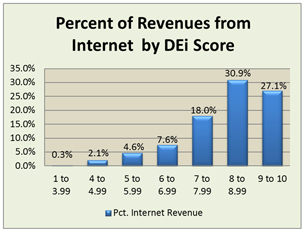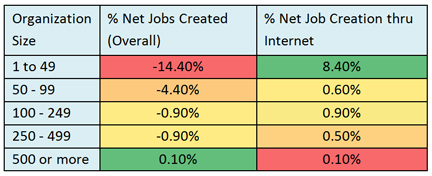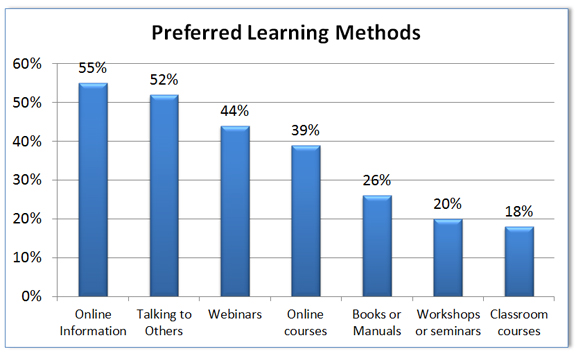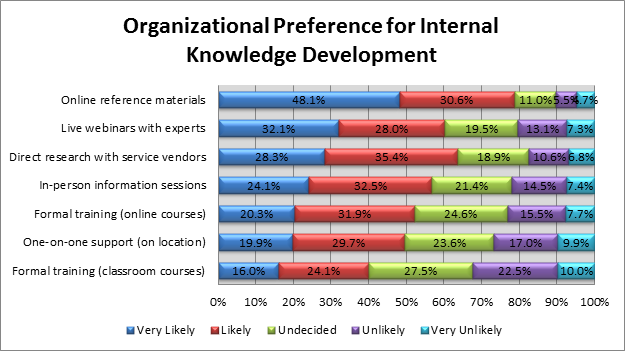September 2011 Bandwidth – SNG Study Shows Broadband and e-Solutions Linked to Business Growth
October 3, 2011
SNG Study Shows Broadband and e-Solutions Linked to Business Growth
by Michael Curri & Doug Adams
An SNG study of nearly 600 businesses in North Carolina has revealed a direct correlation between revenue growth and the adoption and use of e-solutions.
 According to the research, higher levels of utilization generate higher revenues and greater benefits for businesses. The most significant impacts on a firm’s bottom line are more sophisticated e-solutions such as teleworking, selling goods or services online, etc. – which means that firms that are not ‘fully online’ are missing out on significant potential revenue. In some cases they could grow by up to 30%.
According to the research, higher levels of utilization generate higher revenues and greater benefits for businesses. The most significant impacts on a firm’s bottom line are more sophisticated e-solutions such as teleworking, selling goods or services online, etc. – which means that firms that are not ‘fully online’ are missing out on significant potential revenue. In some cases they could grow by up to 30%.
By measuring over 17 activities classified as “e-solutions,” or Internet enabled applications, SNG has developed a Digital Economy index (DEi) which measures the utilization of broadband as a platform for innovation. DEi scores range from 1 to 10 (10 being highest), with higher scores reflecting the greater the number, scope and sophistication of the Internet activities deployed in an organization.
The data indicate that businesses with a high DEi, meaning higher levels of adopting and using e-solutions, experience larger percentage increases of revenues (between 27 and 31%).
SNG’s research thus demonstrates that increasing Internet utilization dramatically increases corporate revenues and job creation.
The Impact of Broadband on Jobs
The North Carolina study reveals that the Internet contributes significantly to job growth, especially among organizations with less than 50 employees who represent over 94% of all firms and 44% of all employment.
The table below shows a complex dynamic where large numbers of jobs in over 1,000 organizations were created and lost over a 12 month period in 2009/2010. As in any economy where there is job creation and job loss, the most important challenge is to drive net positive job growth. North Carolina is seeing job loss (as shown in “% Net Jobs Created”). The key is how many sustainable, knowledge sector jobs they can create through innovation.
As the column “% Net Jobs Created thru Internet” indicates, small, nimble firms (less than 50 employees) are leveraging the Internet and e-solutions and creating new jobs at a rate of more than 8% of their existing base, which is a significant difference from the over 14% decline in job losses overall.
 This picture of both job creation and loss is a more realistic insight into the process of economic change and development within North Carolina. One key finding from this table is that jobs associated with use of the Internet grew across all organizational sizes, even while major job losses were being experienced. This is particularly significant in organizations with 1 to 49 employees.
This picture of both job creation and loss is a more realistic insight into the process of economic change and development within North Carolina. One key finding from this table is that jobs associated with use of the Internet grew across all organizational sizes, even while major job losses were being experienced. This is particularly significant in organizations with 1 to 49 employees.
Broadband for Startups and Small Firms
Contributed by Roland J. Cole, Ph.D., J.D.
Residential broadband (distinguished from commercial broadband) is critical for bottom-up economic development. With this, there are a number of regions in the US (and in other countries) where big entities – private firms as well as government agencies, universities, and hospitals have access to broadband that is high speed and affordable, but the residences in that same community do not. In the US, while federal funds are being allocated to extend broadband to “community anchor institutions,” including hospitals, there is little or nothing being done to extend it to the residences around those institutions. I’ve seen one hospital program myself that refuses to share access with the offices of doctors that serve in the hospital, let alone the homes where they live. I’ve learned of a city that has, to great acclaim, extended its fiber to large firms, but feels that residences and small firms do not need anything better than the cable and telephone companies are currently providing.
As SNG has reported (most recently in the June Issue of Bandwidth that prompted me to write this piece), a lot of purely “economic” activity takes place in homes or in sites small enough that broadband network operators treat them as homes. In North Carolina, 1/3 of those with broadband already had a home-based business, and more than 1/10 were planning to start one within the year. These activities are in addition to employees of large firms that work from home. They are also above and beyond those using the Internet to seek employment opportunities, apply online, improve their skills, etc.
We’ve all heard stories of firms – countless numbers of them – that grew from basements, spare bedrooms, and garages. HP started in a garage; Dell started in a university dorm room. Some large firms that now include access to high-speed affordable broadband for their buildings as a top five or top ten item are now including access for their employees’ homes as a part of that item.
Residential broadband is important even for the firms that are out of the home, because small non-residential sites get offered the same bandwidth deals that homeowners get offered, albeit usually at twice or three times the price. The network providers (both public and private) do special deals for large end-users, but NOT for small ones.
Better bandwidth for these purposes is not just “speed” and price, because “speed” usually refers to download speed – largely a measure of consumption, not production. These individuals and small firms are producing, as well as consuming, and can use upload speed as well as download.
Video files are huge, CAD files are enormous, high-resolution photo files are large, database files have never been dainty… and you’re hard pressed to find organizations that do not include designers, marketers, architects, and engineers who need to transport these files. Of course you could deliver thumb drives with such files… but I also could send a letter as opposed to an email. I need to remain competitive, agile, and flexible to succeed in 2011. Lack of better broadband may not prevent home-based and small firm economic activity, but it sure discourages it. Better broadband provides the platform… the foundation to foster activities that grow businesses, and with them, our economies.
So for one measure of how “fertile” the ground is for bottom-up economic development activity in your community, track the price and upload speed offered to your residences. Do not be satisfied when your big companies and your “community anchor institutions” have reasonable broadband while residences do not. A big aid to the firms of the future, both large and small, is better residential bandwidth now.
Roland J. Cole is a lawyer and policy analyst (PhD/JD Harvard) who has been studying small business and economic development for over 30 years. His work has included three textbook chapters on the role of residential broadband and the development of a toolkit for community action in support of broadband improvement. He is currently a freelance policy analyst in Austin Texas, launching a new organization entitled Fertile Ground for Startups and Small Firms.
Learning about Learning Preferences
As a part of each SNG study, we take a close look not only at adoption rates and driving utilization – but also at preferred learning methods to bridge their skills gaps. It’s about individual users understanding which e-solutions will give them the biggest benefits and having the capacity to use those applications.
When individuals and households need to acquire knowledge, they turn to the resources they have at hand – and of course, the learning methods they prefer. It’s about moving businesses, organizations and households up the learning curve more effectively so that they realize the benefits from broadband and e-solutions as quickly and fully as possible.
Not surprisingly to our marketing department, among households “word of mouth” still scores high as a means for learning. But traditional methods are clearly taking a back seat to online learning – both informal (general surfing) and formal (webinars and online courses). Books, workshops, and classes all come after online methods (and word of mouth) as preferred learning methods. So it is clear that we have a bit of ‘chicken and the egg’ situation here as the question becomes – how does someone maximize their learning potential, without having online resources? The digital divide obviously goes hand-in-hand with a knowledge gap.

The same study revealed that 2 in 3 organizations plan to acquire at least two distinct skills sets over the next year – some through hiring, and some through training.
Here again we see a preference for online learning methods as self-directed methods of knowledge development, including online research and webinars, are the most likely to be used by the majority of organizations. In-person classroom training is the least likely method to be used.

So, when planning for broadband, also plan for learning. Not only is it important to understand where the awareness and skills gaps are, but also understanding the preferred modes of learning. An effective strategy for economic development through broadband requires this.

